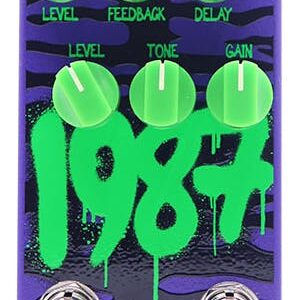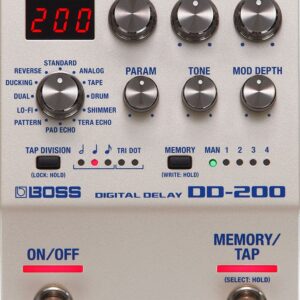Delay

A delay pedal is used to create an echo effect by repeating the original sound after a short time. It works by capturing the input signal and then replaying it with adjustable delay time and feedback. The longer the delay time and the more feedback, the more pronounced the repeating echo becomes, adding depth and space to the sound.
There are different types of delay pedals, including analogue, digital, and tape delay. Analog delay provides a warmer, more natural echo, while digital delay offers clear, precise repeats and additional features like tap tempo. Tape delay mimics the sound of vintage tape machines, adding a distinctive, slightly warbled effect. Delay pedals are widely used across genres to create atmosphere, enhance solos, or add complexity to rhythms.
AllPedal Animals Pedals Asheville Music Tools Behringer Benson Amps Boss Catalinbread Crazy Tube Circuits Danelectro Diamond Pedals DOD Dreadbox EarthQuaker Devices Electro Harmonix Empress Effects Eventide Fairfield Circuitry Fender Fjord Fuzz Flattley Guitar Pedals Free The Tone Gamechanger Audio GFI System HOTONE Ibanez Jam Pedals JHS Pedals Jim Dunlop Keeley Electronics KMA Audio Machines Landlord FX Laney Line 6 LR Baggs Mad Professor Meris Mooer MXR Nobels NUX Old Blood Noise One Control Rainger FX Red Panda Silktone Source Audio Strymon Suhr T Rex TC Electronic Tone City Universal Audio Walrus Audio Wampler Way Huge
Showing 1–30 of 130 results
-
Alexander Pedals History Lesson V3 Delay Pedal
£219.00 -
Alexander Pedals Rewind Programmable Echo Delay Pedal
£239.00 -
Alexander Pedals Superball Kinetic Modulator Dynamic Delay Pedal
£199.00 -
AllPedal Devils Triad Jeff Loomis Signature Distortion Boost Delay Reverb Pedal
£349.00 -
AllPedal Steel Panther Signature Delay Distortion Pedal
£219.00 -
Animals Pedals Relaxing Walrus Delay Pedal
£89.00 -
Asheville Music Tools ADG-1 Analogue Delay Pedal
£419.00 -
Asheville Music Tools ADG-1 Anologer Delay Pedal in Textured Black
£419.00 -
B Stock : Hotone Binary EKO delay Pedal 0001
£55.00 -
Behringer VD400 Vintage Analogue Delay Pedal
£21.99 -
Benson Amps Analogue Delay Pedal
£289.00 -
Black Country Customs by Laney The Difference Engine Stereo Delay Pedal
£239.00 -
Boss DD-200 Digital Delay Pedal
£229.00 -
Boss DD-3T Digital Delay Pedal
£129.00 -
Boss DD-8 Digital Delay Pedal
£159.00 -
BOSS DD500 Digital Delay Pedal
£389.00 -
Boss DM-101 Delay Machine Pedal
£399.00 -
BOSS DM-2w Delay Pedal
£175.00 -
Boss RE-2 Space Echo Delay Pedal
£190.00 -
Boss RE-202 Space Echo Delay Pedal
£319.00 -
Boss SDE-3 Dual Digital Delay Pedal
£169.00 -
Boss SDE-3000D Dual Digital Delay Pedal
£399.00 -
BOSS TE-2 Tera Echo Adaptive Delay Pedal
£159.00 -
Catalinbread Adineko Oil Can Delay Pedal
£179.00 -
Catalinbread Soft Focus Deluxe Shoegaze Reverb Delay Pedal
£359.00 -
Crazy Tube Circuits Sidekick Chorus, Flanger, Delay & Reverb Multi-FX Pedal
-
Crazy Tube Circuits Sidekick JR Junior Chorus Flanger Delay Reverb Multi FX Pedal
£249.00 -
Crazy Tube Circuits Time Digital Delay Pedal
£159.00 -
Danelectro Back Talk Reverse Delay Pedal
£189.00 -
Diamond Dark Cloud Textural Delay Pedal
£255.00






























